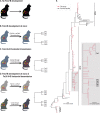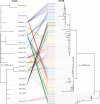Feline Leukemia Virus (FeLV) Endogenous and Exogenous Recombination Events Result in Multiple FeLV-B Subtypes during Natural Infection
- PMID: 34232703
- PMCID: PMC8387034
- DOI: 10.1128/JVI.00353-21
Feline Leukemia Virus (FeLV) Endogenous and Exogenous Recombination Events Result in Multiple FeLV-B Subtypes during Natural Infection
Abstract
Feline leukemia virus (FeLV) is associated with a range of clinical signs in felid species. Differences in disease processes are closely related to genetic variation in the envelope (env) region of the genome of six defined subgroups. The primary hosts of FeLV are domestic cats of the Felis genus that also harbor endogenous FeLV (enFeLV) elements stably integrated in their genomes. EnFeLV elements display 86% nucleotide identity to exogenous, horizontally transmitted FeLV (FeLV-A). Variation between enFeLV and FeLV-A is primarily in the long terminal repeat (LTR) and env regions, which potentiates generation of the FeLV-B recombinant subgroup during natural infection. The aim of this study was to examine recombination behavior of exogenous FeLV (exFeLV) and enFeLV in a natural FeLV epizootic. We previously described that of 65 individuals in a closed colony, 32 had productive FeLV-A infection, and 22 of these individuals had detectable circulating FeLV-B. We cloned and sequenced the env gene of FeLV-B, FeLV-A, and enFeLV spanning known recombination breakpoints and examined between 1 and 13 clones in 22 animals with FeLV-B to assess sequence diversity and recombination breakpoints. Our analysis revealed that FeLV-A sequences circulating in the population, as well as enFeLV env sequences, are highly conserved. We documented many recombination breakpoints resulting in the production of unique FeLV-B genotypes. More than half of the cats harbored more than one FeLV-B variant, suggesting multiple recombination events between enFeLV and FeLV-A. We concluded that FeLV-B was predominantly generated de novo within each host, although we could not definitively rule out horizontal transmission, as nearly all cats harbored FeLV-B sequences that were genetically highly similar to those identified in other individuals. This work represents a comprehensive analysis of endogenous-exogenous retroviral interactions with important insights into host-virus interactions that underlie disease pathogenesis in a natural setting. IMPORTANCE Feline leukemia virus (FeLV) is a felid retrovirus with a variety of disease outcomes. Exogenous FeLV-A is the virus subgroup almost exclusively transmitted between cats. Recombination between FeLV-A and endogenous FeLV analogues in the cat genome may result in emergence of largely replication-defective but highly virulent subgroups. FeLV-B is formed when the 3' envelope (env) region of endogenous FeLV (enFeLV) recombines with that of the exogenous FeLV (exFeLV) during viral reverse transcription and integration. Both domestic cats and wild relatives of the Felis genus harbor enFeLV, which has been shown to limit FeLV-A disease outcome. However, enFeLV also contributes genetic material to the recombinant FeLV-B subgroup. This study evaluates endogenous-exogenous recombination outcomes in a naturally infected closed colony of cats to determine mechanisms and risk of endogenous retroviral recombination during exogenous virus exposure that leads to enhanced virulence. While FeLV-A and enFeLV env regions were highly conserved from cat to cat, nearly all individuals with emergent FeLV-B had unique combinations of genotypes, representative of a wide range of recombination sites within env. The findings provide insight into unique recombination patterns for emergence of new pathogens and can be related to similar viruses across species.
Keywords: feline leukemia virus; genetic recombination; retroviruses.
Figures



Similar articles
-
Presence of Endogenous Viral Elements Negatively Correlates with Feline Leukemia Virus Susceptibility in Puma and Domestic Cat Cells.J Virol. 2020 Oct 14;94(21):e01274-20. doi: 10.1128/JVI.01274-20. Print 2020 Oct 14. J Virol. 2020. PMID: 32817213 Free PMC article.
-
Endogenous Feline Leukemia Virus (FeLV) siRNA Transcription May Interfere with Exogenous FeLV Infection.J Virol. 2021 Nov 9;95(23):e0007021. doi: 10.1128/JVI.00070-21. Epub 2021 Sep 8. J Virol. 2021. PMID: 34495702 Free PMC article.
-
Feline Leukemia Virus (FeLV) Disease Outcomes in a Domestic Cat Breeding Colony: Relationship to Endogenous FeLV and Other Chronic Viral Infections.J Virol. 2018 Aug 29;92(18):e00649-18. doi: 10.1128/JVI.00649-18. Print 2018 Sep 15. J Virol. 2018. PMID: 29976676 Free PMC article.
-
Quantification of endogenous and exogenous feline leukemia virus sequences by real-time PCR assays.Vet Immunol Immunopathol. 2008 May 15;123(1-2):129-33. doi: 10.1016/j.vetimm.2008.01.027. Epub 2008 Jan 19. Vet Immunol Immunopathol. 2008. PMID: 18295344 Review.
-
What role do endogenous retroviruses play in domestic cats infected with feline leukaemia virus?N Z Vet J. 2023 Jan;71(1):1-7. doi: 10.1080/00480169.2022.2131648. Epub 2022 Oct 26. N Z Vet J. 2023. PMID: 36178295 Review.
Cited by
-
Long-term surveillance of the feline leukemia virus in the endangered Iberian lynx (Lynx pardinus) in Andalusia, Spain (2008-2021).Sci Rep. 2024 Mar 5;14(1):5462. doi: 10.1038/s41598-024-55847-3. Sci Rep. 2024. PMID: 38443503 Free PMC article.
-
Could Phylogenetic Analysis Be Used for Feline Leukemia Virus (FeLV) Classification?Viruses. 2022 Jan 26;14(2):249. doi: 10.3390/v14020249. Viruses. 2022. PMID: 35215842 Free PMC article.
-
Prevalence and genetic characterization of feline leukemia virus in portuguese stray cats.BMC Vet Res. 2025 Mar 26;21(1):205. doi: 10.1186/s12917-025-04691-2. BMC Vet Res. 2025. PMID: 40133929 Free PMC article.
-
Field Performance of a Rapid Test to Detect Progressive, Regressive, and Abortive Feline Leukemia Virus Infections in Domestic Cats in Australia and Germany.Viruses. 2023 Feb 10;15(2):491. doi: 10.3390/v15020491. Viruses. 2023. PMID: 36851705 Free PMC article.
-
Molecular investigation and genetic characterization of feline leukemia virus (FeLV) in cats referred to a veterinary teaching hospital in Northern Italy.Vet Res Commun. 2024 Aug;48(4):2683-2689. doi: 10.1007/s11259-024-10380-6. Epub 2024 Apr 22. Vet Res Commun. 2024. PMID: 38644457 Free PMC article.
References
-
- Chiu ES. 2019. Role of endogenous retrovirus in control of feline leukemia virus infection and implications for cross species transmission. Colorado State University Libraries, Fort Collins, CO.
Publication types
MeSH terms
Substances
Grants and funding
LinkOut - more resources
Full Text Sources
Miscellaneous

